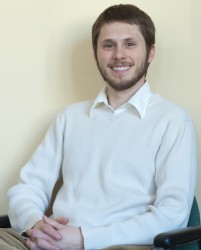Fowler, Goupee Awarded OMAE 2014 Best Paper of Ocean Renewable Energy Symposium

A paper titled, “Hydrodynamic Module Coupling in the Offshore Wind Energy Simulation (OWENS) Toolkit,” co-authored graduate student Matthew Fowler, Dr. Andrew Goupee, and others, was awarded the OMAE 2014 Best Paper of Ocean Renewable Energy Symposium.
The paper was written in collaboration with Sandia National Laboratories, Texas A&M University, the University of Maine, and the Wave Energy Center in Lisbon, Portugal.
The Award will be formally announced during the luncheon on Tuesday, June 2, at the ASME 2015 34th International Conference on Ocean, Offshore and Arctic Engineering (OMAE2015) conference in St. John’s, Newfoundland.

Abstract:
When considering the future of offshore wind energy, developing cost effective methods of harnessing the offshore wind resource represents a significant challenge which must be overcome to make offshore wind a viable option. As the majority of the capital investment in offshore wind is in the form of infrastructure and operation and maintenance costs, reducing these expenditures could greatly reduce the cost of energy (COE) for an offshore wind project. Sandia National Laboratory and its partners (TU Delft, University of Maine, Iowa State, and TPI Composites) believe that vertical axis wind turbines (VAWTs) offer multiple advantages over other rotor configurations considering this new COE breakdown. The unique arrangement of a VAWT allows the heavy generator and related components to be located at the base of the tower as opposed to the top, as is typical of a horizontal axis wind turbine (HAWT). This configuration lowers the topside CG which reduces the platform stability requirements, leading to smaller and cheaper platforms. Additionally this locates high maintenance systems close to the ocean surface thus increasing maintainability. To support this project and the general wind research community, the Offshore Wind ENergy Simulation (OWENS) toolkit is being developed in conjunction with Texas A&M as an open source, modular aero-elastic analysis code with the capability to analyze floating VAWTS. The OWENS toolkit aims to establish a robust and flexible finite element framework and VAWT mesh generation utility, coupled with a modular interface that allows users to integrate easily with existing codes, such as aerodynamic and hydrodynamic codes.
Current efforts to include a hydrodynamic module are focused on coupling WavEC2Wire with OWENS. WavEC2Wire is a wave-to-wire numerical model developed by Marco Alves at the Insituto Superior Tecnico for the analysis of wave energy converter devices. It has been adapted from its original form and restructured for use as a hydrodynamic module capable of providing OWENS with necessary floating platform dynamics. Hence, WavEC2Wire functions as a rigid-body solver designed to calculate the platform motion due to wave loads, moorings, and the influence of the attached VAWT and tower. This paper presents the WavEC2Wire module and details the OWENS coupling method. Additionally, planned improvements in the WavEC2Wire module as well as future development in OWENS are presented.
To learn more about this conference, visit the following URL: http://www.asmeconferences.org/omae2015/
To download the full paper, visit the following URL: http://energy.sandia.gov/wp-content/gallery/uploads/OMAE2014_24175.pdf
Citation:
Fowler, M.J., Owens, B.C., Goupee, A.J., Hurtado, J.E., Griffith, D.T., and Alves, M., “Hydrodynamic Module Coupling in the Offshore Wind Energy Simulation (OWENS) Toolkit,” Proceedings of the 33rd ASME International Conference on Ocean, Offshore and Arctic Engineering (OMAE2014), June 8–13, 2014, San Francisco, California, USA, Paper OMAE2014-24175.
